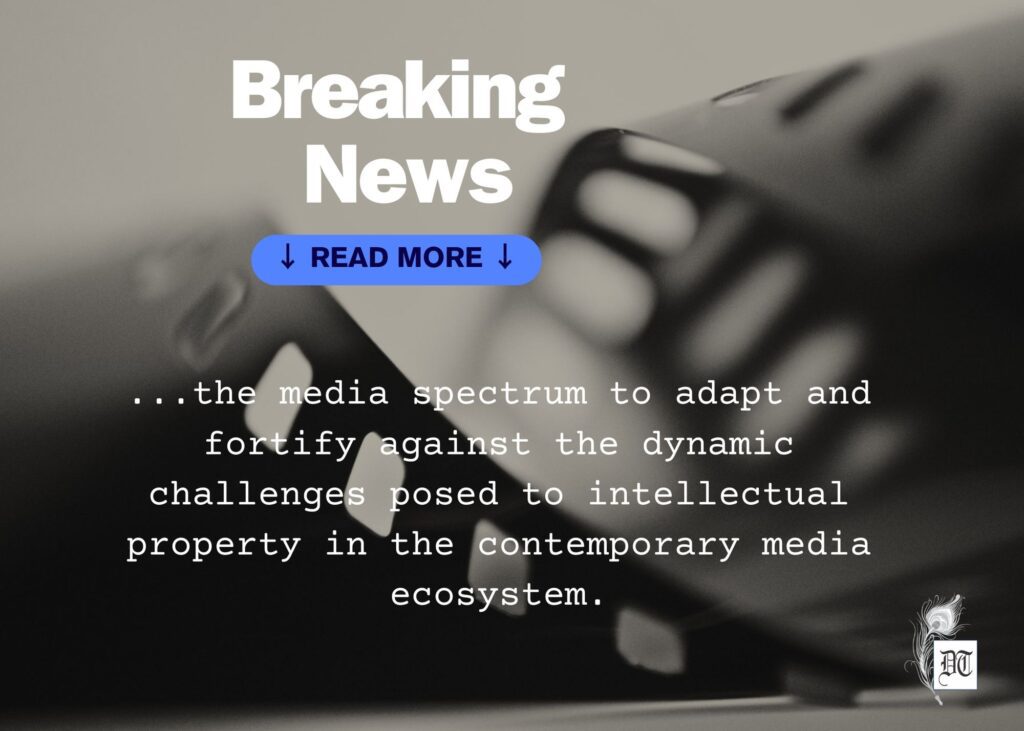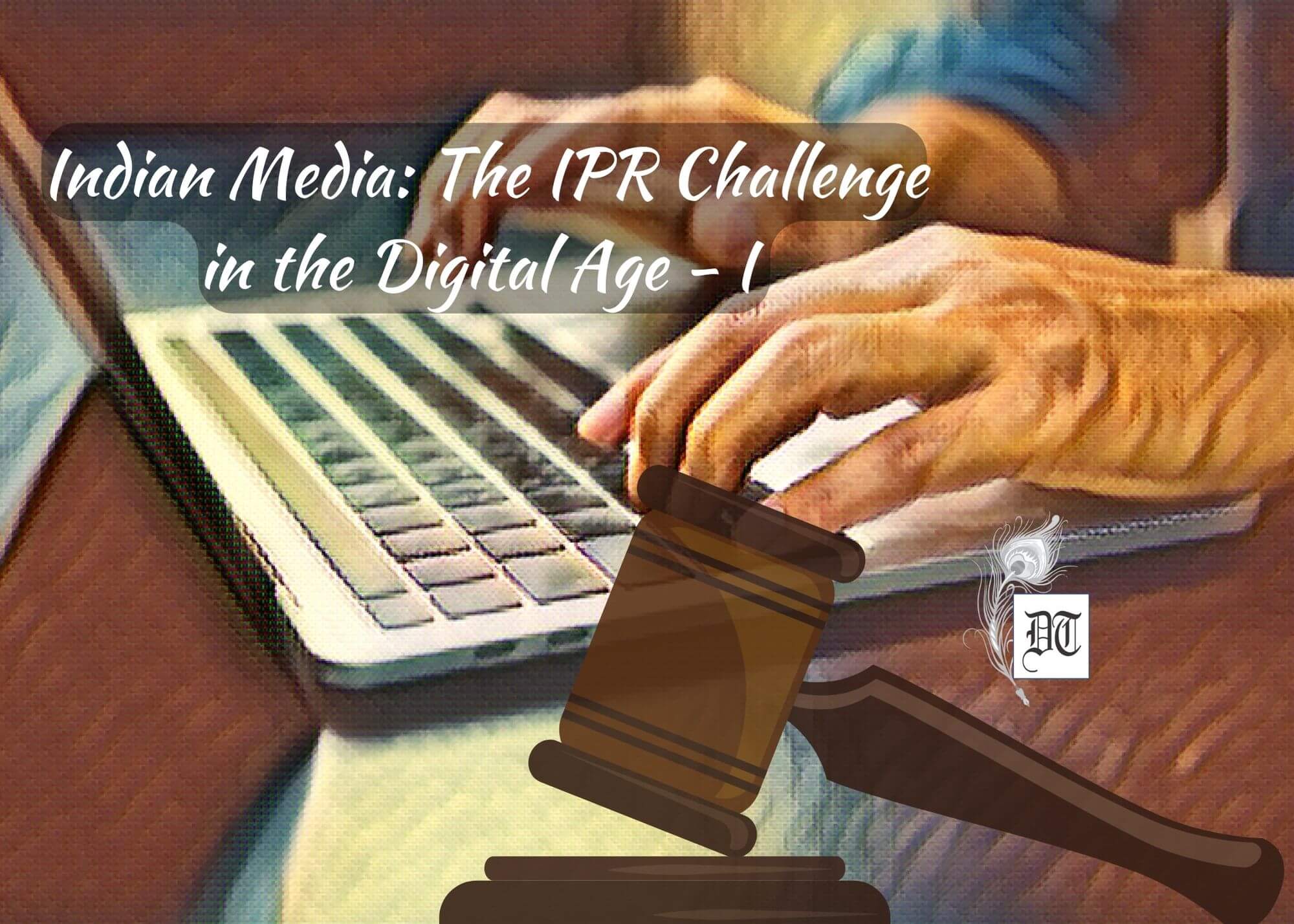Reading Time: 7 minutes
Can India’s booming media landscape, fuelled by copycats and cash grabs, survive without stronger intellectual property protection, asks Arindam, in the first part of his two-part article, exclusively for Different Truths.
Copycats and cash grabs: Can India’s media boom survive without stronger IP protection? Perhaps not.
Let’s explore the intricate relationship between the Indian media industry and Intellectual Property Rights (IPR). It investigates the challenges, legal frameworks, and emerging trends in IPR within the context of the rapidly evolving Indian media landscape. The study employs references to existing literature, legislation, and case studies to provide a holistic understanding of the subject.
The Indian media industry has witnessed exponential growth in recent decades, fuelled by technological advancements and changing consumer habits. With this surge, the protection of intellectual property has become paramount. This article aims to analyse the nuances of Intellectual Property Rights in the Indian media context, drawing insights from scholarly works, legal texts, and practical case studies.
Navigating the IPR Landscape in India’s Dynamic Media
India’s media landscape hums with a vibrant diversity, encompassing everything from the silver screen to digital platforms and the enduring power of print (Chakravarty, 2018). Its relentless evolution, documented by statistics from the Indian Ministry of Information and Broadcasting, showcases an industry in full stride, captivating audiences and leaving its mark on society.
Copyright laws, with their nuances and complexities, form the bedrock.
But this growth necessitates a closer look at the intricate dance between creativity and protection. Navigating the terrain of Intellectual Property Rights (IPR) in this dynamic space demands an understanding of the legal frameworks that shape it. Copyright laws, with their nuances and complexities, form the bedrock. Fair use doctrines provide breathing room for artistic expression, while licensing agreements act as bridges between creators and consumers. Legal interpretations by experts like Bansal (2017) illuminate the labyrinthine alleys of this legal tapestry, ensuring that the wheels of creativity keep turning within the bounds of protection.
Intellectual Property Rights
Understanding the legal landscape is imperative when delving into Intellectual Property Rights (IPR) in India. This section navigates through the key legislative frameworks that constitute the backbone of IPR, namely the Copyright Act of 1957, the Trademarks Act of 1999, and the Patents Act of 1970. Kapoor’s (2020) insightful analysis of these laws sheds light on their intricate provisions and their direct implications for creators within the expansive realm of media.
The Copyright Act of 1957: The Copyright Act of 1957, a cornerstone of India’s intellectual property regime, serves as the primary legislation governing copyright protection. Enacted to safeguard the rights of creators, this law delineates the rights and responsibilities of authors, composers, artists, and other creators of original works. Kapoor’s (2020) analysis dissects the various facets of this act, elucidating the nuanced provisions that pertain specifically to the media industry.
The act encompasses a wide array of works, including literary, artistic, musical, and cinematographic works, crucial within the context of media creation. Kapoor’s examination extends to the implications of these provisions for media creators, addressing issues such as reproduction rights, public performance rights, and the duration of copyright protection. The evolving nature of digital media further adds layers of complexity, making Kapoor’s analysis instrumental in deciphering the contemporary challenges and opportunities within the media domain.
The Trademarks Act of 1999: In the realm of intellectual property, trademarks play a pivotal role in establishing brand identity and protecting the distinctiveness of goods and services. The Trademarks Act of 1999 governs the registration and protection of trademarks in India. Kapoor’s (2020) exploration of this act unravels the intricacies involved in trademark protection, with a specific focus on its implications for media entities.
Media creators often rely on distinctive logos, brand names, and other identifiers to establish a unique identity…
Media creators often rely on distinctive logos, brand names, and other identifiers to establish a unique identity in a crowded landscape. Kapoor’s analysis delves into the criteria for trademark registration, the process of obtaining protection, and the enforcement mechanisms available to media entities. Understanding these aspects becomes paramount for media creators seeking to build and protect their brand identity in a competitive market.
The Patents Act of 1970: While copyright and trademarks safeguard the creative and branding aspects, patents offer protection for inventions and technological innovations. The Patents Act of 1970 governs the grant and regulation of patents in India. Kapoor’s (2020) examination of this act provides valuable insights into how patent protection intersects with the technological facets of media creation.
In the rapidly evolving landscape of media and technology, innovations such as software, algorithms, and unique technological processes play a crucial role. Kapoor’s analysis navigates through the patentability criteria, the application process, and the scope of patent protection within the media industry. Media creators, particularly those involved in technological advancements, benefit from a nuanced understanding of the Patents Act to ensure protection for their innovations.
In conclusion, Kapoor’s (2020) in-depth analysis serves as a guiding beacon, unravelling the complexities of the legal framework underpinning Intellectual Property Rights in India. By providing a comprehensive understanding of the Copyright Act of 1957, the Trademarks Act of 1999, and the Patents Act of 1970, this analysis equips media creators with the knowledge needed to navigate the intricacies of IPR and fortify their creative endeavours within the legal boundaries established by these crucial legislations.
Challenges in Intellectual Property Rights (IPR) Protection for Media Creators
The challenges faced by media creators in safeguarding their intellectual property rights (IPR) are multifaceted and often underscored by real-world instances. Two prominent case studies, the landmark Bollywood film ‘Sholay’ (Rathi, 2015) and the pervasive issue of online piracy (Gupta, 2019), serve as poignant examples, shedding light on the intricate hurdles encountered within the media landscape. These instances not only exemplify the challenges but also underscore the pressing need for robust IPR protection mechanisms.
‘Sholay’ – A Landmark Bollywood Film: The cinematic masterpiece ‘Sholay,’ directed by Ramesh Sippy, stands as an iconic case study in the annals of Indian cinema and IPR challenges. Rathi’s (2015) exploration of the legal intricacies surrounding ‘Sholay’ unravels a tale of copyright disputes, highlighting the complexities media creators encounter in protecting their creative works.
‘Sholay’ faced legal battles, with challenges arising from unclear contractual agreements, conflicting interpretations…
The case revolves around copyright ownership and disputes over the film’s distribution and remakes. ‘Sholay’ faced legal battles, with challenges arising from unclear contractual agreements, conflicting interpretations, and evolving copyright laws. Rathi’s analysis delves into the nuances of the case, showcasing the challenges directors, producers, and other stakeholders face in navigating the legal intricacies of IPR. This landmark example underscores the imperative for media creators to establish clear contractual frameworks and proactively protect their works against potential disputes.

Online Piracy – A Pervasive Challenge: In the digital age, online piracy has emerged as a pervasive and persistent threat to the IPR of media creators. Gupta’s (2019) examination of the prevalence of online piracy provides a contemporary lens on the challenges posed by the unauthorised distribution of creative content.
The proliferation of torrent websites, streaming platforms hosting unauthorized content, and the ease of digital reproduction have posed significant challenges for media creators. Gupta’s case study illustrates how piracy not only impacts revenue streams but also dilutes the exclusivity and uniqueness of creative works. The legal battles against digital piracy involve navigating through jurisdictional challenges, technological advancements, and evolving modes of unauthorised distribution. Gupta’s analysis underscores the urgency for media creators to adopt proactive strategies, including technological measures and legal recourse, to counter the pervasive threat of online piracy.
These case studies, ‘Sholay’ and online piracy, collectively unravel the challenges media creators confront in the realm of IPR protection. The complexities range from contractual ambiguities and copyright disputes to the persistent menace of digital piracy in the online domain. The imperative for robust IPR protection mechanisms becomes evident through these real-world examples, urging media creators to proactively address legal intricacies, fortify contractual agreements, and deploy effective strategies against piracy.
In essence, these challenges underscore the continuous evolution required in the legal and technological strategies employed by media creators. As the digital landscape transforms and creative works find new avenues of distribution, the call for resilient IPR protection mechanisms resonates louder than ever, urging stakeholders across the media spectrum to adapt and fortify against the dynamic challenges posed to intellectual property in the contemporary media ecosystem.
Digital Media and IPR: Navigating Challenges
The advent of the digital revolution has ushered in a transformative era in the media landscape…
The advent of the digital revolution has ushered in a transformative era in the media landscape, significantly altering the dynamics of content creation, distribution, and protection of Intellectual Property Rights (IPR). The rise of prominent streaming platforms such as Netflix and Amazon Prime has not only revolutionised consumer habits but has also given rise to complex challenges surrounding copyright infringement and fair use. This section delves into the implications of digitalisation on IPR, drawing insights from a pertinent case study conducted by Mishra (2021).
The Digital Transformation of Media: The digital revolution has dismantled traditional barriers in the media industry, democratising content creation and distribution. Streaming platforms have emerged as major players, offering a vast array of content accessible at the viewer’s convenience. This paradigm shift, while fostering a diverse content ecosystem, has also presented challenges in protecting the intellectual property of creators in the digital realm.
Streaming Platforms and Copyright Infringement: The surge of streaming platforms has raised critical questions about copyright infringement. Mishra’s (2021) case study delves into instances where digital platforms, in their quest for a vast content library, may inadvertently infringe upon the copyrights of original creators. The study examines legal intricacies surrounding the use of copyrighted material in digital media, exploring scenarios where streaming services may inadvertently breach copyright laws.
Copyright infringement concerns arise when platforms stream content without proper licensing or permissions, impacting the revenue streams of original creators. Mishra’s analysis sheds light on the nuances of these challenges, emphasizing the need for a robust legal framework to address copyright concerns in the dynamic digital landscape.
Fair Use in the Digital Space: The concept of fair use, a legal doctrine allowing the use of copyrighted material for purposes such as criticism, commentary, and news reporting without the need for permission, becomes particularly relevant in the digital context. Mishra’s study examines cases where the line between fair use and infringement blurs, especially in the realm of online content creation and sharing.
With the proliferation of user-generated content on digital platforms, determining what constitutes fair use becomes a complex task.
With the proliferation of user-generated content on digital platforms, determining what constitutes fair use becomes a complex task. The study offers insights into legal precedents and challenges surrounding fair use in the digital space, emphasising the need for clarity in legal standards to balance the rights of content creators and platform operators.
Finally, the impact of digitalisation on IPR in the media industry is profound, marked by the proliferation of streaming platforms and the challenges they pose to copyright protection and fair use. Mishra’s (2021) case study serves as a valuable resource, providing nuanced insights into the evolving landscape of digital media and its implications for IPR.
As the digital ecosystem continues to evolve, stakeholders in the media industry, including content creators, platforms, and policymakers, must proactively address these challenges. A delicate balance between fostering innovation, ensuring access to content, and protecting the intellectual property of creators is essential for the sustainable growth of the digital media landscape. Mishra’s case study serves as a crucial reference point in navigating these complexities, urging the industry to adapt and fortify its approach to IPR in the dynamic and ever-evolving digital era.
Picture design by Anumita Roy















